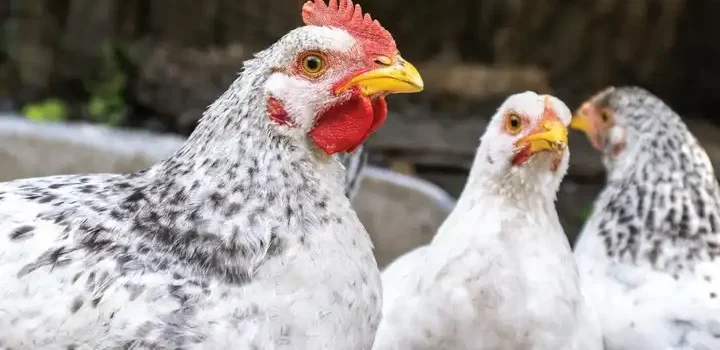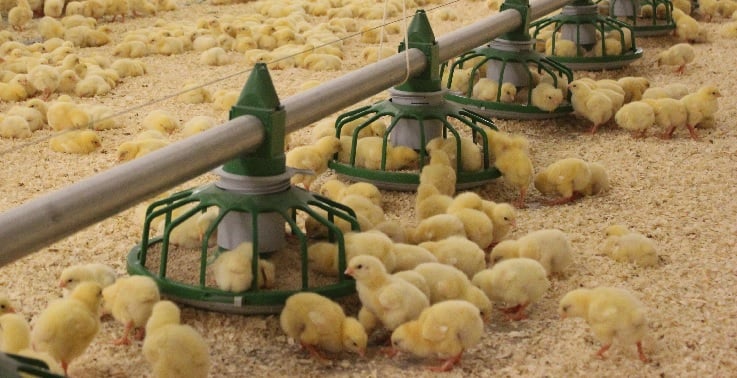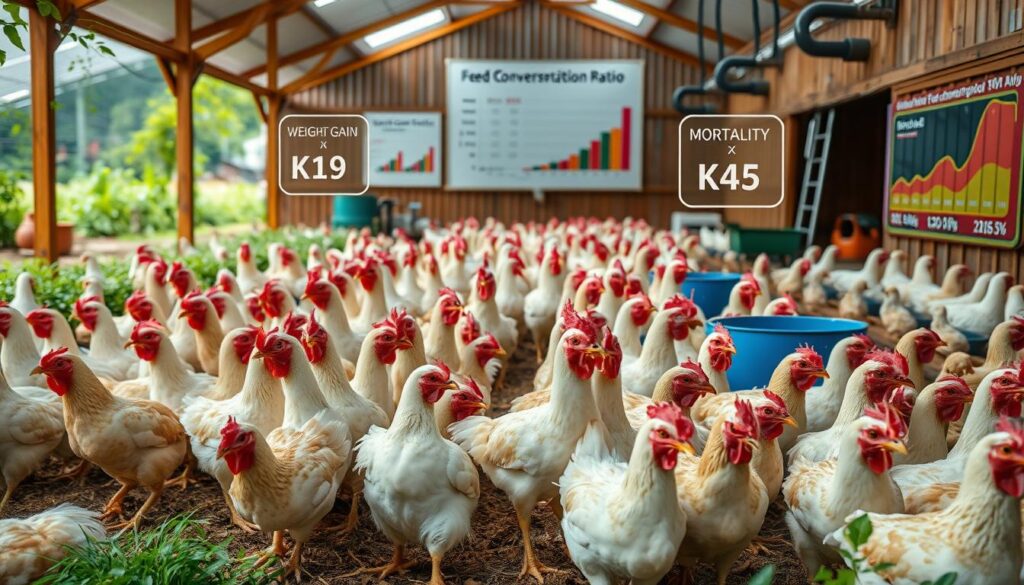
In the world of poultry farming, tracking the right metrics is key. These are called Key Performance Indicators (KPIs). By focusing on KPIs like Feed Conversion Ratio, Mortality Rate, and Average Daily Gain, farms can get better and make more money. This helps farmers make smart choices to boost production, cut costs, and grow their business.
Key Takeaways
- Key Performance Indicators (KPIs) are critical metrics for measuring and improving broiler chicken growth and production efficiency.
- Understanding and optimizing KPIs like Feed Conversion Ratio, Mortality Rate, and Average Daily Gain can significantly boost a farm’s productivity and profitability.
- Monitoring broiler health, environmental factors, and genetic factors are essential for optimizing KPIs and driving business performance.
- Proper nutrition, housing conditions, and disease prevention protocols are crucial for maintaining optimal broiler growth and performance.
- Accurate data collection and analysis are key for making informed decisions to improve broiler farming operations.
Understanding Key Performance Indicators (KPIs) for Broiler Chicken
Growth
Key Performance Indicators (KPIs) are key metrics for poultry farmers. They help track the efficiency and profit of their farms. By monitoring these metrics, farmers can make better decisions to boost production and cut costs.
KPIs greatly affect a farm’s success. They offer insights into different parts of the operation. This helps farmers spot areas to improve and plan better strategies.
Definition and Importance of KPIs
KPIs measure how well a business meets its main goals. For broiler chicken farms, they help track performance. This allows farmers to make decisions based on data.
These metrics act as benchmarks. They help farmers compare their results to industry standards. This way, they can find chances to get better.
Impact on Productivity, Efficiency, and Profitability
Using KPIs well can greatly improve a farm’s productivity, efficiency, and profit. By tracking metrics like Feed Conversion Ratio (FCR), Mortality Rate, Average Daily Gain (ADG), and Egg Production Rate, farmers can find ways to get better. For example, better FCR means less feed costs and more weight gain, boosting profit.
| Key Performance Indicator | Industry Benchmark | Elite Performance |
|---|---|---|
| Feed Conversion Ratio (FCR) | 1.5 to 2.0 kg feed/kg gain | As low as 1.3 |
| Mortality Rate | 3% to 5% for broilers | Below 2% for exceptional performance |
| Average Daily Gain (ADG) | 0.8 to 1.2 pounds per day | – |
| Egg Production Rate | 90% to 95% for well-managed flocks | – |
By focusing on these KPIs, broiler chicken farmers can improve their farms. This leads to better productivity, efficiency, and profit. It helps make the farm more successful overall.
Feed Conversion Ratio (FCR)
In the poultry industry, the Feed Conversion Ratio (FCR) is key. It shows how well broiler chickens turn feed into body mass. FCR is found by dividing the total feed eaten by the total weight gained.
Definition and Calculation
The FCR is the ratio of feed eaten (in kilograms) to weight gained (in kilograms) by chickens. A lower FCR means better feed use and more profit for farms. The goal is to get an FCR between 1.7 and 2.0, with the best farms aiming for 1.3.
Industry Benchmarks and Optimization Strategies
The average FCR for broiler chickens is about 1.8. To get the best FCR, farms can try these:
- Use high-quality, nutrient-rich feed to meet the birds’ needs
- Keep the birds healthy to avoid wasting feed
- Adjust feeding based on the birds’ growth and environment
- Use technology and data to make better feeding choices
Improving FCR helps farms be more productive, efficient, and profitable.
Mortality Rate
The mortality rate in poultry farming shows how well a flock is doing. It’s the percentage of birds that die in a certain time, usually the flock’s whole life. The goal is to keep it between 3% to 5%.
Significance and Calculation Method
Figuring out the mortality rate is easy. You just use the formula: Mortality Rate = (Number of Deaths / Total Number of Birds) x 100. For example, if 30 birds out of 1,000 die, the rate is 3%.
Keeping the mortality rate low is key for success in poultry farming. High rates can hurt the business a lot. So, it’s important to watch and control this key number.
Factors Influencing Mortality and Mitigation Strategies
- Disease Outbreaks: Good vaccination and biosecurity can stop diseases and lower death rates.
- Nutritional Imbalances: A balanced diet helps keep the flock healthy and lowers death rates.
- Environmental Stressors: Good housing, temperature, and air can reduce stress and help the birds.
- Management Practices: Watching the flock closely, catching problems early, and acting fast can lower death rates.
By focusing on managing mortality rates, poultry farmers can do better. They can increase productivity and make more money from their chicken farms.

| Poultry Type | Industry Benchmark Mortality Rate |
|---|---|
| Broiler Chickens | 3% to 5% |
| Layer Hens | 5% to 7% |
| Turkeys | 3% to 7% |
Average Daily Gain (ADG)
Average Daily Gain (ADG) is key for poultry farmers. It shows how much a broiler chicken gains weight each day. This affects how profitable a farm can be, making it very important to watch and improve.
The ADG for broiler chickens usually falls between 0.8 to 1.2 pounds per day. This can change based on the chicken’s breed, age, and how it’s managed. To get the best ADG, farmers need to focus on feed, keeping the farm clean, and the environment.
Recent studies show that the Intestinal Integrity score (IIS) was lower in 2021 compared to 2020 and 2019. But, for every one-unit increase in intestinal integrity, the Average Daily Gain (ADG) goes up by 0.04G. This means better gut health can really help broiler chickens grow faster.
- Improving the Intestinal Integrity score by 5 points could make a poultry company £572,000 richer. This is for a farm that raises 100 million broilers a year.
- Also, going from an Intestinal Integrity score of 90 to 100 can make the Feed Conversion Ratio (FCR) better. This shows how important it is to keep the gut healthy.
Keeping the gut healthy is getting harder as broilers are under more stress. By watching ADG and fixing gut health issues, farmers can make their flocks grow better and more efficiently. This can really help their bottom line.
Tracking Broiler Health and Performance
Keeping an eye on broiler chicken health and performance is key for top results. It’s important to watch body weight and environmental factors closely. These can greatly affect the birds’ health and growth.
Body Weight Uniformity
It’s vital to keep broiler flock weights consistent. This helps manage growth better. Checking individual bird weights regularly gives insights into growth consistency.
This data helps spot issues like feed problems or health issues. These can hurt the whole flock’s performance.
Environmental Factors and Monitoring
The environment where broiler chickens live is very important. Things like temperature, humidity, air quality, and ventilation need to be just right. Monitoring these helps farmers keep their birds healthy and growing well.
| Environmental Factor | Optimal Range |
|---|---|
| Temperature | 75-85°F (24-29°C) |
| Humidity | 50-70% |
| Air Quality (Ammonia) | Less than 25 ppm |
By tracking body weight and environmental factors, farmers can improve their flocks’ health and performance. This leads to better productivity and profits.
Key Performance Indicators (KPIs) for Broiler Chicken Growth
Getting broiler chickens to grow well is key for better productivity and profits. Farmers need to watch Feed Conversion Ratio (FCR), Mortality Rate, Average Daily Gain (ADG), Body Weight Uniformity, and Environmental Factors closely.
The Feed Conversion Ratio (FCR) shows how much feed is needed for each chicken. Keeping FCR low helps save on feed costs. The goal is to get it below 1.7, and farmers are always trying to improve.
The Mortality Rate is another important KPI. It shows how healthy the chickens are. Lower mortality means more productive flocks and less loss for farmers. Good health comes from preventing diseases and keeping the environment clean.
- A study in Brazil found using a special vaccine for Infectious Bronchitis Disease helped reduce chicken waste at slaughterhouses.
- Keeping poultry healthy, especially from diseases like Infectious Bronchitis and Gumboro Disease, is crucial for processing plants to avoid big losses.
The Average Daily Gain (ADG) measures how fast chickens grow. Faster growth means more chickens ready for market sooner, boosting farm productivity.
Body Weight Uniformity is also key. It affects how well chickens can be processed. Uniform weights mean less trouble at the processing plant.
“Big differences in broiler weight can make a big gap between expected and actual carcass weight. This affects market standards and brand trust.”
Lastly, environmental factors like where chickens live, temperature, and air quality are very important. Good conditions help chickens grow and stay healthy.

By focusing on these KPIs, farmers can make their broiler chicken operations more productive and profitable. This helps the whole industry grow and thrive.
Genetic Factors and Selection Criteria
Genetic factors are key in broiler chicken growth and performance. Choosing the right breeds with high genetic potential can greatly affect metrics like Average Daily Gain (ADG) and Feed Conversion Ratio (FCR). Understanding genetic factors and strategic breed selection help poultry producers boost their broiler operations’ productivity and efficiency.
Breed Selection and Genetic Potential
Finding broiler breeds with top genetic potential is vital for better growth and feed use. Breeders must look at different breeds’ performance, like growth rate, feed conversion, and disease resistance. Choosing the best breeding stock ensures broiler flocks can thrive and reach production targets.
Maintaining Healthy Breeding Stock
Keeping the breeding stock healthy is key for high-performing broiler chickens. Good health monitoring, biosecurity, and nutrition programs are essential. Regular vet visits, disease prevention, and the right food help keep the breeding stock fit and productive.
“Genetic factors have a profound impact on broiler chicken growth and performance. By carefully selecting breeds with superior genetic potential and maintaining the health of the breeding stock, producers can unlock the full productive capacity of their flocks.”
Nutrition Optimization for Broiler Growth
Improving the nutrition of broiler chickens is key to their growth and health. A balanced diet with the right nutrients helps them grow better. This includes better feed conversion ratio (FCR), average daily gain (ADG), and health.
Working with poultry nutritionists and testing feed is important. It ensures broilers get the best nutrition for their needs.
Balanced Diet and Feed Formulation
Making a balanced diet for broiler chickens is complex. It involves mixing proteins, carbohydrates, fats, vitamins, and minerals correctly. This supports their fast growth and development.
Understanding the birds’ nutritional needs is crucial. These needs change based on age, breed, and goals.
Feed Additives and Supplements
Using feed additives and supplements can also improve nutrition. Ingredients like enzymes and probiotics help with nutrient absorption and gut health. They also boost the immune system.
Choosing the right feed additives and supplements is important. The right amount can lead to better FCR, ADG, and flock performance.
“Optimizing broiler nutrition is not a one-size-fits-all approach. It requires a deep understanding of the birds’ individual needs and a willingness to adapt feed formulations based on ongoing monitoring and analysis.”
By focusing on broiler nutrition, balanced diet, feed formulation, feed additives, and supplements, farmers can improve their flocks’ performance. This leads to better productivity, efficiency, and profits.
Data Collection and Analysis
Getting accurate data collection and analysis is key to good broiler chicken farming. Keeping detailed record-keeping of important indicators like feed use, weight gain, and death rates helps farmers spot trends. They can fix problems and make smart choices based on data.
The Importance of Accurate Record-Keeping
Good record-keeping lets farmers see how their broiler flocks do over time. By tracking things like feed conversion ratio (FCR), average daily gain (ADG), and mortality rate, they can find useful insights. This helps them make better choices to boost their farm’s success.
Leveraging Technology for Data Management
New technology is changing how broiler farmers handle data collection and analysis. Tools like automated monitoring systems and advanced data management software make it easy to collect and understand important data. These tools help farmers make quick, informed decisions to keep improving their farms.
“Adopting new technologies, such as big data analytics and Cloud computing, can improve bird performance and increase farm output.”
By using data collection, record-keeping, and data analysis, broiler chicken farmers can reach their full potential. They can make every part of their flock management better, leading to more productivity and profit.
Environmental Management and Biosecurity
Good environmental management and strong biosecurity are key for raising healthy broiler chickens. Keeping the right temperature and air flow is crucial for their health and happiness.
Housing Conditions and Temperature Control
First, we need to make sure the chickens have a good place to live. This means keeping the temperature between 68°F and 77°F. Good ventilation also helps keep the air clean and comfortable for them.
Disease Prevention and Biosecurity Protocols
Stopping diseases is vital for keeping the chickens healthy and productive. This means using vaccines, controlling who comes in, and cleaning the area often. By doing this, we can keep our chickens safe and growing well.
| Key Performance Indicator | Industry Benchmark | Example Calculation |
|---|---|---|
| Feed Conversion Ratio (FCR) | 1.5 – 2.0 kg feed/kg gain | FCR = 1,800 lbs / 1,200 lbs = 1.5 |
| Mortality Rate | 3% – 5% | Mortality Rate = (30 / 1000) x 100 = 3% |
| Average Daily Gain (ADG) | 0.8 – 1.2 pounds per day | ADG = (5 – 4) / 10 = 0.1 pounds per day |
By managing the environmental conditions well and using strong biosecurity protocols, farmers can keep their chickens healthy and growing. This leads to better productivity, efficiency, and profits.
In the world of poultry farming, it’s key to track and improve key takeaways for optimizing broiler chicken growth to boost profitability. Understanding metrics like Feed Conversion Ratio, Mortality Rate, and Average Daily Gain helps farmers. This knowledge leads to better operations, lower costs, and more profit.
By using data well and improving nutrition and the environment, farmers can grow sustainably. This approach is crucial for success in the broiler chicken industry.
Poultry producers can make better choices by focusing on important performance indicators. This helps solve problems and keeps improving operations. Whether it’s better feeding, housing, or using new tech, data-driven growth is the way to go.
As the industry grows, staying ahead means using KPIs wisely. By focusing on key takeaways and growth strategies, farmers can thrive. They’ll be ready for the future of the broiler chicken industry.